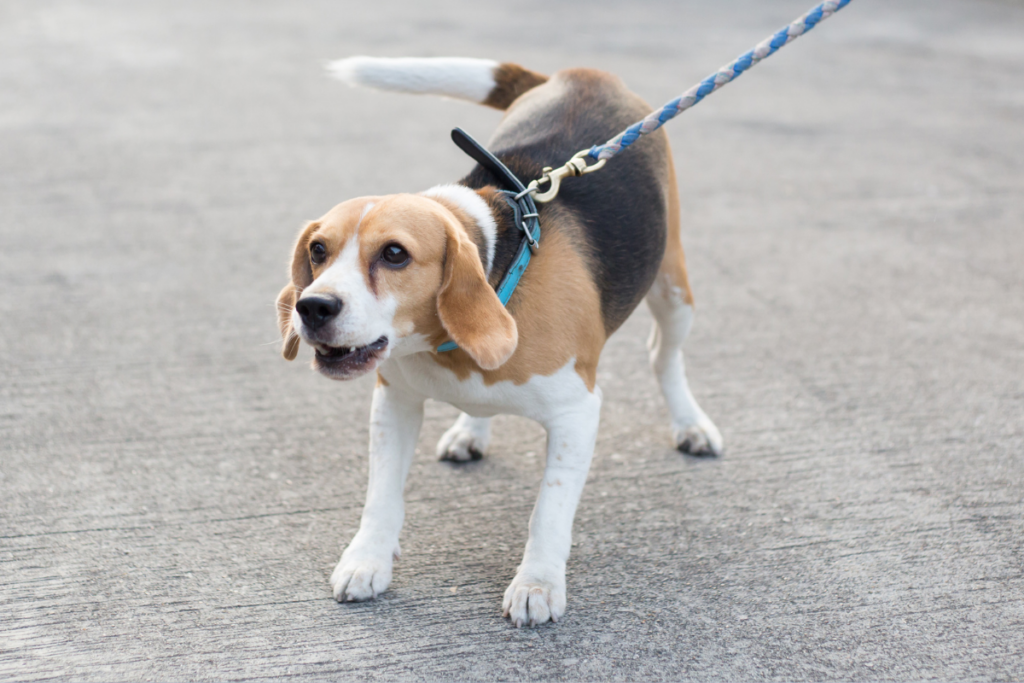It can be very frightening when a dog shows aggressive behavior and even more so if they have not exhibited any aggression in the past. Your dog might have been an easy going pup who got along with other animals and people and then suddenly a situation arises where they begin to exhibit aggressive behavior—barking, growling, even trying to bite. These aggressive behaviors are not normal, and they can and should be managed with careful training and a visit to the veterinarian.
Typical aggressive behaviors in dogs are threatening or harmful postures and actions that include becoming still and rigid, growling, giving a deep and threatening bark, showing teeth, or nipping or biting, and they can stem from a variety of causes. If you can understand what is contributing to your dog’s new behavior, you can work with your fur friend to limit the causes and get back to enjoying life together.
What creates aggression in dogs? How do we manage it?
Reactivity:
One of the main causes of sudden aggression in dogs is reactivity. Reactive dogs respond to certain stimuli (other dogs on leashes, loud noises, men with beards, running or shouting children, for example) in a negative and fear-based way that can lead to an aggressive behavior. This fear response can result in growling or even biting from a reactive dog.
Work to identify situations that trigger a reactive dog and pay close attention to the dog’s body language. Defusing a situation before it reaches the point where your dog responds aggressively is key. Be direct and clear with other people to tell them your dog doesn’t like to be patted on the head or approached by dogs when he’s on a leash. Reward-based positive training can focus on limiting the reactive response to the trigger stimulus, but you always want to establish a safe environment for your dog and others before beginning to try to diminish the aggressive reaction.
Health issues:
Just as humans can be snappy and angry when we don’t feel well, dogs sometimes exhibit aggressive behavior because they are experiencing severe pain. An untreated ear infection, joint discomfort, tooth decay, or cancer are a few of the medical situations that can lead a dog to lash out. Medical problems such as hypothyroidism or a Lyme disease infection can also lead to a dog becoming suddenly aggressive.
Always take extra caution when handling an injured dog, as even your best friend might respond aggressively when they are in extreme pain. Regular veterinary checkups and consulting with your vet if your dog seems ‘off’ or is showing sudden aggression can help ensure there is not an underlying health problem causing the behavioral issue.
Resource guarding:
Resource guarding can lead to canine aggression when the dog feels that a cherished or important item is in danger of being taken away. Dogs guard favorite toys, food, bedding or chosen nap spots, and even certain people, and they will respond with aggression if they feel they might lose the item. This behavior can be particularly troublesome with multiple dogs in the house. Often this is the only instance where the dog will respond aggressively to humans or to other dogs.
Offer your dog an item that is equally amazing to lessen their desire to keep something. If your dog is guarding a toy, try to give it a new toy or a treat and make a trade for the guarded object. Keep other dogs away during mealtimes to prevent fights or eating too fast to protect their meal. Teaching the command “leave it” can help a dog learn that it’s ok to give up something that is important to them.
Territorial aggression:
This is similar to resource guarding but the resource in this case is your dog’s territory, whether that is his dog bed, your house, your yard, or even the neighborhood. They also might become aggressive if they feel their people are in danger. Dogs with territorial aggression do not respond negatively to the same stimulus when it is not on their turf—for example a dog might have no problem meeting people but goes crazy barking when someone approaches the front door.
Limiting your dog’s interaction with or making the stimulus more positive are a few ways to address this form of aggression. If your dog barks at everything outside the window, perhaps window shades will help. Have visitors text rather than ring the doorbell to prevent an aggressive response. Leave a bag with a few treats outside for visitors to give your dog once she is calm inside.
Fear:
Many dogs respond to fearful situations with their ‘fight or flight’ physiological response. Particularly if a dog feels cornered or confined, they might see an aggressive response as the only safe way forward.
Working with your dog through positive and supportive training can help them gain confidence and limit fear responses.
Frustration:
Frustration often leads to what is called ‘redirected aggression’. For example, a dog who spends the day lunging at the end of its lead and growling at passersby might redirect that aggression when someone comes to take him off his tether and snap at them, or a dog might bite at the person who tries to split up a dog fight.
Increasing daily exercise will give your dog an opportunity to expend their excess energy in a safe and fulfilling way. The physical activity of a fun daily walk, hike, or run will help them rest easily at home and enjoy extra time with you.
The bottom line
It can be frightening and dangerous when a dog suddenly shows aggressive behavior. Understanding what might be causing it will go a long way in helping you to work with your fur friend to limit these experiences. The most fundamental part of raising a dog is to be sure they have ample opportunities for socialization when they are young. This leads to a confident pup who can enter freely into any situation and not experience the stress that can lead to aggression. Never get in between two dogs who are fighting, and be careful when handling an injured animal. There are times when what might seem like aggressive behavior is actually normal. Sometimes dogs play in a way that looks like they are being aggressive; as long as it is mostly noise and your dog can be distracted and calmed all should be fine. Puppies naturally learn about their world with their mouths, and all puppies do some biting and nipping. On the contrary, suddenly displaying aggressive behavior is not typical for a dog, and you should always consult with your veterinarian.
Sources:
https://www.aspca.org/pet-care/dog-care/common-dog-behavior-issues/aggression
https://www.akc.org/expert-advice/training/reactivity-vs-aggression/









